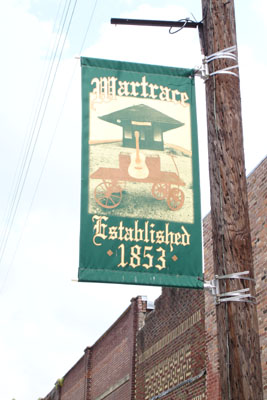Wartrace, Tennessee

>Home
>Community Introduction
>Photo Gallery
<Previous
>Next
"Founded in 1853, Wartrace is a Victorian village, with both Victorian and Antebellum homes, nestled in the heart of Tennessee Walking Horse country, 60 miles southeast of Nashville. The rolling green hills of eastern Bedford County are the birthplace of the Tennessee Walking Horse, and Wartrace itself is steeped in the history of the Civil War, the American railroad, and Tennessee Folk music.
History of Wartrace
"In 1851, Rice Coffee donated eight acres of land to the railroad in exchange for the railroad coming through the property. In 1852, the Nashville, Chattanooga and St. Louis Railway projects were completed through Bedford County, and the first train rolled through. In 1853, the community petitioned Bedford County for a charter, and on October 3, they were granted a charter as Wartrace Depot. These tracks still run through the center of town, with the downtown district facing the tracks to create a square. The site of the long-gone freight and passenger depots are now known as Memorial Park.
"Wartrace also gathers distinction as the 'Cradle of the Walking Horse.' The first celebration of the Walking Horse was held September 7-9, 1939, in Wartrace. The judges’ stand from the first celebration is located in the center of what is now the downtown parking area and remains that area’s focal point. The idea for the Tennessee Walking Horse National Celebration is generally credited to the late Henry Davis of Wartrace. Strolling Jim, 1939’s National Grand Champion, died in 1957 and is buried here on the grounds of the Walking Horse Hotel. The hotel, built in 1917 as the Overall Hotel, was home to Strolling Jim for many years. It was renamed the Walking Horse Hotel, which better identifies its long history with Walking Horses.
"Wartrace enjoys a distinguished educational history. The Wartrace Academy, Wartrace Male and Female Institute, and the Brandon Training School are three names for a 19th century school located between present-day College and Summit Streets. The building was constructed of hand-made bricks from a kiln on Wartrace Creek. When the school was torn down in the late 1800s, three residences were built on College Street from the bricks. Several homes in Wartrace were used as boarding houses for students who came from as far away as Oklahoma.
"During the Civil War, Wartrace was an important part of the Tullahoma Campaign. Confederate Corporal Commander William J. Hardee was headquartered at Beechwood Plantation House, now know as BeechWood Farm. The Plantation House was built for Colonel Andrew Erwin, Jr., and his family in 1826. The Erwins, who were southern sympathizers, lavishly entertained local society and Confederate officers during the Civil War. On March 27, 2004, a historical marker at the farm was dedicated, commemorating Beechwood Plantation’s role in local Civil War history.
"The Wartrace name comes from its original use as a trail for the Cherokee Indians. In 1813, General Andrew Jackson was said to have carved 'This is War Trail Creek' into a beech tree near the stream."
(Text used by permission of the Wartrace Chamber of Commerce.)